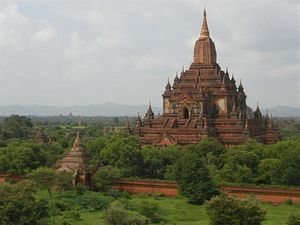Myanmar has been in the news lately due to the Rohingya crisis, which is attracting the attention of not just the world media, but also international visitors. While U.S. Secretary of State Rex Tillerson flagged the issue during his visit, the Pope did not make a direct reference to the persecution of Rohingya Muslims, though he did repeatedly speak of the need for reconciliation between different communities. With the country’s image suffering, Myanmar’s tourism sector is extremely important, not just in terms of helping the economy, but also in allaying misconceptions about the country and projecting Myanmar’s positive side.
Myanmar’s political transition, along with the opening up of the country’s economy, provided a boost in the number of tourists visiting the country. In 2015, Myanmar was able to attract nearly 5 million tourists, but in 2016 this dropped to less than 3 million. When the ruling National League for Democracy (NLD) appointed U Ohn Maung, a hotelier, as minister for hotels and tourism, the move was widely praised and sent a positive message with regard to the priority being accorded to tourism by the NLD government.
The successes achieved in the tourism sector are clearly visible in foreign direct investment (FDI) figures. In 2011, FDI in Myanmar’s tourism sector amounted to $1.14 billion spread among 36 projects. This went up to almost $3 billion in 2016, according to the Ministry of Hotels and Tourism. ASEAN countries led the way. Singapore ($1.6 billion) whose presence has generally increased, emerged as the largest investor, followed by Thailand ($445 million) and Vietnam ($440 million).
The tourism sector has also played a role in some 1.5 million jobs in 2016, while tourist receipts reached an estimated $2.2 billion.
In an effort to further increase those numbers, Myanmar has joined hands with Cambodia to create a tourist corridor. Only recently, Cambodia and Myanmar signed a memorandum of understanding on boosting to the flow of national and third-country tourists to the temples of Angkor in Siem Reap and to the ancient city of Bagan in Myanmar. According to Tith Chantha, secretary of state in Myanmar’s Ministry of Tourism, “The memorandum focuses on creating a single tourist destination, Angkor-Bagan, to attract tourists to the area for the benefit of both countries.”
Can India, which also shares historic links with Myanmar, explore similar opportunities with Myanmar?
India could look to connect Bodh Gaya in Bihar state, Sanchi (Madhya Pradesh), and the upcoming capital of Amaravati (Andhra Pradesh) with Buddhist sites in Myanmar. This is very much in sync with the Indian government’s emphasis on utilizing Buddhism for promoting Indian soft power, and giving a boost to its Act East policy.
Apart from Buddhist sites in India, a potential India-Myanmar tourist circuit could also include historical sites in Myanmar. There are a number of important historical sites which would be of interest to Indian tourists, including temples in Yangon and the grave of the last Mughal Emperor, Bahadur Shah Zafar, who was exiled to Myanmar by the British. The possibility of a Cambodia-Myanmar-India circuit can also be explored, given the increasing importance which India is giving to the grouping of Cambodia, Myanmar, Laos, and Vietnam (CMLV countries).
However, there are a number of obstacles towards the promotion of such a corridor.
First, Myanmar faces a perception problem. Even before the Rohingya crisis, Myanmar was not able to attract tourists due to a lack of awareness about the country. This is in spite of the fact that there are important historical sites in Myanmar, and the country has immense potential of becoming a top class tourist destination.
Second, at the moment, hotels in Myanmar are overpriced compared to neighboring Thailand and Cambodia. This is offered as one of the reasons why Myanmar has lost out to neighboring countries, especially Cambodia. If tourists from abroad are to be encouraged, there needs to be a serious rethink on Myanmar’s hotel prices.
Third, it is imperative to have greater air connectivity between Myanmar and India ahead of boosting bilateral tourism or creating any potential tourist corridor. Myanmar has good air connectivity with countries like Thailand, but there is a need for more direct flights with India. Apart from Bodh Gaya, other important Buddhist sites in India need to have more connecting flights with Yangon.
While jointly promoting tourism may be a tough task, there is immense scope for cooperation. India has played a positive role in assisting Myanmar in areas like capacity building, and has sought to build a holistic relationship, not a transactional one. Deeper cooperation on tourism will only strengthen linkages at the people-to-people level and deepen bonds between both countries.
Tridivesh Singh Maini is a New Delhi based Policy Analyst associated with the Jindal School of International Affairs, OP Jindal Global University, Sonipat.

































